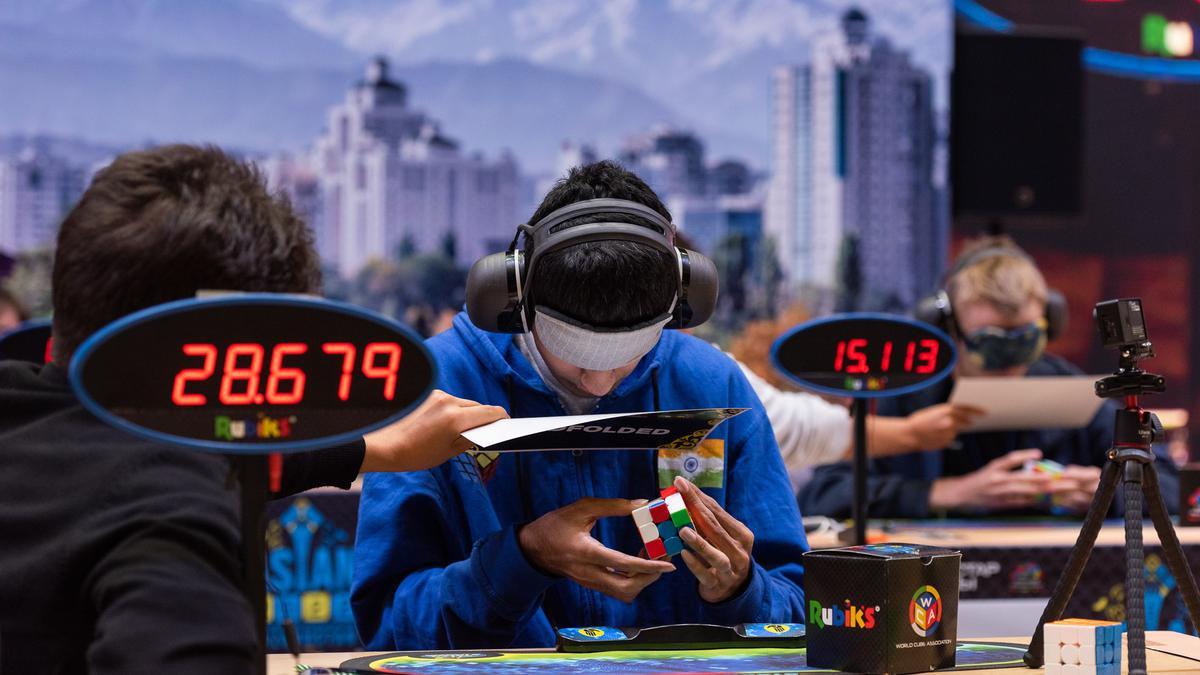
Last month, on the 50th anniversary of the Rubik’s Cube, Mitsubishi Electric’s TOKUFASTbot shattered records by solving a 3×3 puzzle in just 0.305 seconds — a time equivalent to a blink of the human eye. While the human record for solving a 3×3 Cube stands much higher at 3.13 seconds, achieved by USA’s Max Park in 2023, the incredible feat by the robot emphasizes the technological advancements paralleled by human efforts in the world of cubing. According to the World Cube Association (WCA), there are currently 2,21,713 cubers worldwide, with 17,610 of them residing in India. Leading the pack in India is 17-year-old Abhishek R. from Kerala, with an impressive personal best of 9.71 seconds.
Since its invention half a century ago, the Rubik’s Cube has seen considerable evolution, with enthusiasts constantly pushing the boundaries of what is possible in this unique puzzle-solving game. Although India’s presence on the global cubing map remains modest compared to other nations, there is a burgeoning community within the country that is poised to leave a significant mark on the international stage.
Back in 2011, the Indian Institute of Technology Bombay (IIT-B) took a pioneering step in promoting cubing by forming a Rubik’s Cube Club, driven by the enthusiasm of its students. Just a year later, the institute set a world record for the most people solving the Cube simultaneously, with 937 participants completing the puzzle in under 30 minutes. This achievement has fuelled a growing interest in the game, predominately among males. The club even organizes a post-dinner Rubik’s Cube workshop as an icebreaker for incoming students each July, further nurturing the community. This year, they aim to host a WCA-sanctioned tournament, according to Yash Kulkarni, a third-year student of Metallurgy Engineering and Materials Science and current manager of the club.
The club’s activities have provided a platform for many budding cubers, including Abhijeet Ghodgaonkar, a former research fellow at IIT-B who is now a scientific officer at Tata Institute of Fundamental Research. Abhijeet, who has been deeply involved in the cubing scene since 2019, serves as a WCA trainee delegate for the India West region and an Advisory Council Member.
. He has competed in and organized numerous cubing contests within India and internationally, participating in 89 WCA competitions across four countries. Currently the Asian champion and national record holder in the 4×4 and 5×5 blindfolded categories, Abhijeet emphasizes the importance of passion in the sport. “We want to encourage more people to take up the Cube,” he says, pointing out the lack of governmental sponsorship and recognition for cubing as a sport.
Among the cubing elite is Shivam Bansal, a 24-year-old software professional from Agra who began his cubing journey in 2010. Shivam has set multiple records, including being a former world record holder in 3×3 multi-blindfolded (MBLD). He currently ranks fourth in that category and holds the title of Asian champion in both 5×5 blindfolded and MBLD. Additionally, he is India’s top-ranked cuber in the Kinch ranking system, a testament to his all-around skills. “The inspiration runs in the family,” he proudly shares, mentioning his sister Saumya, who has also made her mark as the only Indian female cuber to participate in two world championships and a former national record holder in Pyraminx and Skewb.
With an eye on the upcoming Rubik’s WCA Asian Championship 2024 in Malaysia and the WCA World Championship 2025 in Washington, Bansal remains a prominent figure in Indian cubing.
Another key player contributing to the cubing culture is Soham Adarkar, co-founder of Cubenama, an online store specializing in cubing supplies. Since 2015, Soham has been active in both competing and organizing events, participating in 42 competitions and facilitating over 30 official and several unofficial events across multiple Indian states. According to Soham, organizing a Rubik’s Cube competition requires a strong understanding of the game, a suitable venue, and a dedicated team. “Once the prerequisites are met, you send a request to WCA, which regulates all official speed cubing competitions globally,” he explains.
Despite the Chess-dominant reputation of India, the Rubik’s Cube remains underestimated and is often seen merely as a toy. This perception is surprising, especially given the country’s ability to produce numerous chess grandmasters. Adarkar continues, “Although the competitions are self-funded and the organizers do not profit as the WCA is a recognized non-profit, we do it for the community.”
As the cubing community in India continues to grow and thrive, there are hopes that this mind-bending sport will eventually gain the recognition and support that it deserves, paving the way for future international successes.












